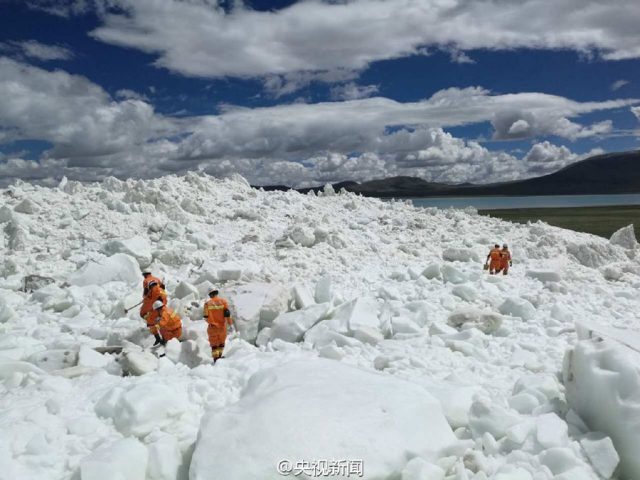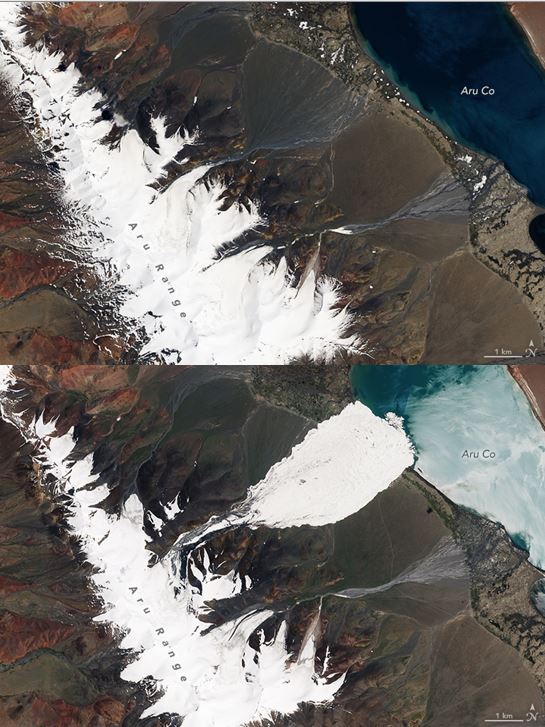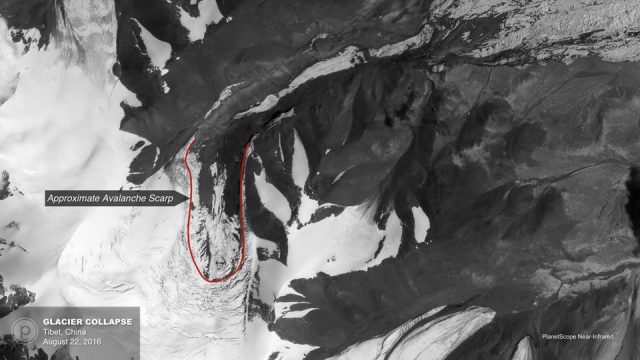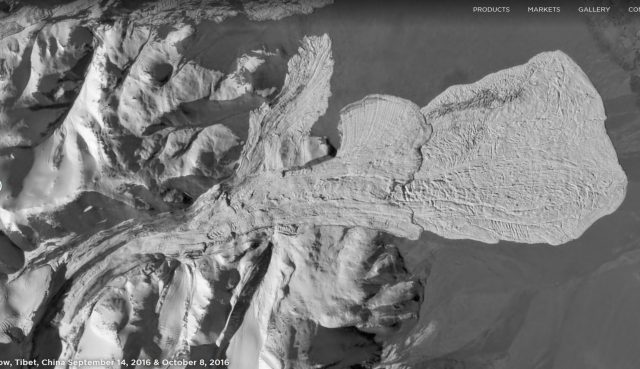24 October 2016
The mysterious Tibetan ice avalanches of summer 2016
Posted by Dave Petley
The mysterious Tibet avalanches of summer 2016
At the start of the summer, a somewhat mysterious giant ice avalanche occurred in the Aru mountains above Lake Aru Co, the first of a pair of Tibet avalanches in this region. This was covered by Xinhua, with a strong sense of surprise.
The avalanche in southwest China’s Tibet Autonomous Region on Sunday was a glacier slide, it has been confirmed. A 600-meter rescue passage had been completed Wednesday morning, but no signs of life have been detected. Nine people, buried by the icefall in Dungru Village in Rutog County, Ngari Prefecture, on Sunday, were confirmed dead on Monday. … “Rescue work is continuing, while the cause of the ice avalanche is being investigated to avoid secondary disasters”, said Zhang Jianping, a police officer directing the rescue. UAV aerial images show that the icefall took place between glaciers on two snow-capped mountains at an altitude above 6,000 meters.
CriEnglish included some images of the avalanche:

One of the Tibet avalanches, via Cri-English
.
It is hard to fathom this size of this event, but satellite images help. The European Space Agency imaged it with the EOI instrument, generating this before and after pair of shots (via NASA):

The first of the Tibet avalanches, imaged by the EOI instrument (via NASA)
.
This is a very large event – estimated at 60 million cubic metres and with a deposit that covers some 10 square kilometres. Few such events have been previously described, so their mechanisms are poorly understood. The Atlantic has a really nice article about this event, highlighting the work of Andrea Kaab at the University of Oslo, who has been investigating it. This includes a nice image of the source area, captured by Planet:

The source area of the first of the Tibet avalanches, via Andreas Kaab and The Atlantic. Image collected by Planet
.
But there is another really surprising aspect of this event, as The Atlantic describes:
This Planet imagery revealed new aspects of the Tibetan glacier. Before the Aru glacier failed, it looked like it was about to surge. Water pooled on its surface, and crevasses started to appear. Surging, though, is a regular part of a glacier’s life. Why had the Tibetan glacier failed catastrophically and not started surging like it should have?
For now, this question will require further study. More worrying was a feature that Kääb noticed in a Sentinel-2 image, something to the south of the avalanche’s debris field. Another glacier had started exhibiting the same characteristics as the Tibetan glacier which collapsed. It showed large crevasses. Would it collapse as well?
This second glacier collapsed on 21st September, generating another enormous avalanche deposit. Planet has a high resolution image of this second event; the edge of the remains of the first deposit are just visible at the top of the image:

The second of the Tibet avalanches, image by Planet
.
The one such event should occur is remarkable; two is unprecedented. In fact the second avalanche look to me to be two separate events, the larger of which occurred first, based on the apparent presence of two deposits in the above image.
The most likely explanation for the Tibet avalanches, and the associated glacial collapse, is climate change. That Tibet is warming rapidly, and that the glaciers are retreating rapidly in response, is well-established. This style of extreme mass movement appears to be a rather dramatic, and worrying, response.
Previous posts that might be of interest
- More information on the disastrous mining-induced landslide in Tibet a fortnight ago
- So was the Tibet landslide, which killed 83 people, really “natural”? You be the judge
- The first anniversary of the Gorkha earthquake in Nepal: the Langtang rock and ice avalanche
- Reports of a massive ice – rock avalanche in Akto County, Xinjiang, China?
- The Siachen Glacier avalanche (138 people killed) was an ice-rock avalanche
- The physics of snow and ice – two videos
- A new mechanism for landslide initiation
Acknowledgement
Thanks to Dustin Rainey for pointing this one out to me.


 Dave Petley is the Vice-Chancellor of the University of Hull in the United Kingdom. His blog provides commentary and analysis of landslide events occurring worldwide, including the landslides themselves, latest research, and conferences and meetings.
Dave Petley is the Vice-Chancellor of the University of Hull in the United Kingdom. His blog provides commentary and analysis of landslide events occurring worldwide, including the landslides themselves, latest research, and conferences and meetings.
I think that the contribution of the Planet imagery is a bit overstated. In this case Planet images do not add much to what could be already inferred from non-commercial imagery (mainly EU Copernicus). Planet is a private agency so they probably have a better communication than Copernicus though… Further reading: “Scientists anticipate another glacier collapse in Tibet from satellite data” http://www.cesbio.ups-tlse.fr/multitemp/?p=8802
[Interesting, thanks. I respect your opinion, but do not agree. Different types of satellite imagery provide different types of insight. The availability of Planet imagery is very welcome. I would add that I have no link to Planet. D.]